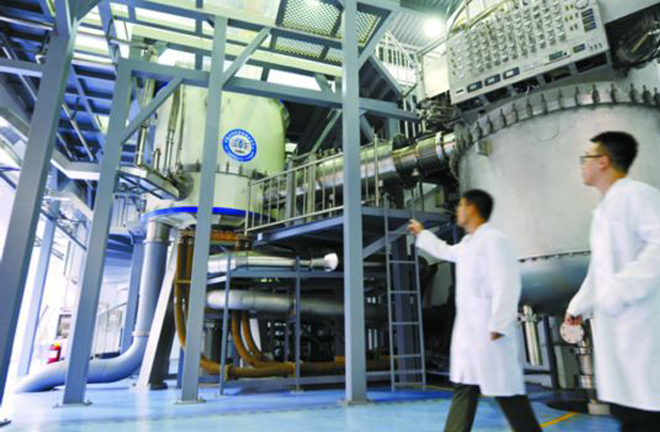Technology innovation centers to lead regional development

Researchers check the Steady High Magnetic Field Facility located in the Hefei Comprehensive National Science Center in Anhui Province. (PHOTOT:XU MINHAO/ANHUI DAILY)
A symposium on the construction of science and technology innovation centers and talent aggregation was recently held by Shanghai Jiao tong University (SJTU), attracting scholars from the University of the Chinese Academy of Sciences, Nanjing University, SJTU and other scientific institutes.
Innovation resources are highly mobile, while research and development require the special aggregation of resources. Hence, the construction of centers for science and technology innovation plays a significant role in attracting global innovation talent, developing industries with cutting-edge technologies and raising national competitiveness.
In May this year, the National Development and Reform Commission and the Ministry of Science and Technology jointly approved the establishment of the Huairou Comprehensive National Science Center (CNSC) in Beijing, which made it the third one following the Zhangjiang CNSC in Shanghai and Hefei CNSC in Anhui Province.
The establishment of innovation centers is a gradual process that cannot be achieved in one day, said Li Xia, a professor from the School of the History and Culture of Science at SJTU. Innovation is rare and costly, he said.
The establishment of science centers has several prerequisites. The first is the basic supporting conditions, which include the institutional, economic and cultural environment as well as the support of human resources and public opinion, he said.
Cost advantages and aggregation effects are also important, Li said. In addition, universities, scientific institutes and enterprises in the region are the necessary carriers of scientific and technological innovation, he said, adding that the technological features of different cities will attract researchers who have different personal tastes.
The basic scientific and technological infrastructure lays the material foundation for the development of science. The aggregation of scientific infrastructure is a contemporary trend, said Shang Zhicong, a professor of philosophy from the University of the Chinese Academy of Sciences. As disciplines divide and intersect, great changes are underway in the researching methods and organizational forms of the scientific institutes. Consequently, individual scientific infrastructure has become integrated into the clusters, Shang said. Major scientific infrastructure should be developed and integrated into a cluster while the corresponding research institutes should also form a comprehensive scientific center, he said.
Basically, the scientific facilities should serve the national tasks. Shang said that the infrastructure should be guaranteed to be open, shared and operated with high efficiency. In this way, the aggregation effects of this infrastructure can be realized, he added.
Without a good environment for innovation, the centers for science and technology will be impossible. Jiang Meishi, a professor of philosophy from Central South University, said innovative culture is the soul of the establishment of science and technology centers. Innovative culture is an important source of competitiveness for enterprises, he said. Effective innovative culture relies on the ability to identify the key factors driving innovation, and fostering this culture, in return, will agglomerate these factors, Jiang said.
In addition, innovation requires a favorable environment that can facilitate communication between clients and managers, he said. The managers should be able to collect innovative ideas as well as assess and finance new programs, he added. Fostering public awareness of the importance of scientific innovation, promoting the interaction and mutual trust between the scientific community and the public, and fostering entrepreneurship and an innovative spirit are the three methods through which an innovation culture can be established, he said.
